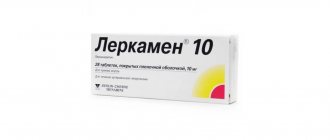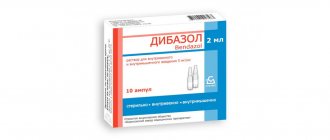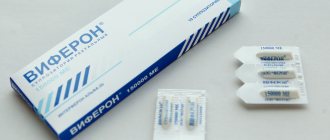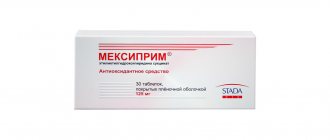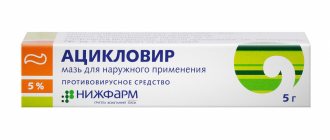Compound
| Each tablet contains the active substance: | |
| Erythromycin (in terms of active substance) 250 mg | |
| Tween-80 (polysorbate) | 5.8 mg |
| Calcium stearate | 4.8 mg |
| Polyvinylpyrrolidone (povidone) | 29.6 mg |
| Croscarmellose sodium | 9.0 mg |
| Potato starch | To obtain an uncoated tablet weighing 450.0 mg |
| Shell excipients: | |
| Titanium dioxide | 0.5 mg |
| 1,2-propylene glycol | 2.3 mg |
| Collicut MAE 100R | 15.1 mg |
| Talc | 4.1 mg |
Description:
Round biconvex tablets, film-coated, white or white with a grayish tint; On a cross section, the core is white or almost white.
Pharmacotherapeutic group: antibiotic - macrolide.
ATX code:
J01FA01
Pharmachologic effect:
Pharmacodynamics
A bacteriostatic antibiotic from the macrolide group, reversibly binds to the 50S subunit of bacterial ribosomes, blocks protein synthesis, prevents the growth and reproduction of bacteria (does not affect the synthesis of nucleic acids). In high doses it can have a bactericidal effect. The spectrum of activity includes gram-positive (Staphylococcus spp., producing and non-producing penicillinase, including Staphylococcus aureus; Streptococcus spp. (including Streptococcus pneumoniae, Streptococcus pyogenes), alpha-hemolytic streptococcus (Viridans group), Bacillus anthracis, Corynebacterium diphtheriae, Corynebacterium minutissimum) and gram-negative microorganisms (Neisseria gonorrhoeae, Haemophilus influenzae, Bordetella pertussis, Brucella spp., Legionella spp., including Legionella pneumophila) and other microorganisms: Mycoplasma spp. (including Mycoplasma pneumoniae), Chlamydia spp. (including Chlamydia trachomatis), Treponema spp., Rickettsia spp., protozoa: Entamoeba histolytica, Listeria monocytogenes.
Gram-negatives are resistant to erythromycin: Escherichia coli, Pseudomonas aeruginosa, as well as Shigella spp., Salmonella spp. and others. The sensitive group includes microorganisms whose growth is delayed at an antibiotic concentration of less than 0.5 mg/l, moderately sensitive - 1-6 mg/l, moderately resistant and resistant - 6-8 mg/l.
Pharmacokinetics
Absorption is high. Eating does not affect the absorption of erythromycin enteric-coated tablets. The maximum concentration (Cmax) is reached after 2-4 hours. Communication with plasma proteins is 70-90%.
Bioavailability - 30-65%. It is distributed unevenly in the body. It accumulates in large quantities in the liver, spleen, and kidneys. In bile and urine, the concentration is tens of times higher than the concentration in plasma. Penetrates well into the tissues of the lungs, lymph nodes, middle ear, prostate secretions, sperm, pleural cavity, ascitic and synovial fluid. In the milk of lactating women, the concentration of erythromycin is 50% of the serum concentration. Penetrates poorly through the blood-brain barrier. During inflammatory processes in the meninges, their permeability to erythromycin increases slightly. Penetrates through the placental barrier.
Metabolizes in the liver (more than 90%), partially with the formation of inactive metabolites. The half-life (T1/2) is 1.4-2 hours, with anuria - 4-6 hours. Excretion with bile - 20-30% unchanged, by the kidneys (unchanged) - 2-5%.
Antibiotic "Erythromycin": description
The drug is an antibiotic with the same active ingredient. Available in tablet form. Each tablet contains 100 mg of erythromycin. Auxiliary components are potatoes, talc, castor oil and others.
Affects gram-positive and gram-negative bacteria, including streptococci, bacilli and others. Used to treat infectious diseases - sore throat, diphtheria, whooping cough, syphilis and many others.
The drug is stored under normal room conditions at a temperature of no more than 25 degrees. Humidity is moderate; protection from direct rays is also required. Access for children is prohibited. The medicine can be used within the general shelf life, which is 2 years from the date of production.
Indications for use
Infectious and inflammatory diseases caused by sensitive microflora: diphtheria (including bacterial carriage), whooping cough (including prevention), trachoma, brucellosis, Legionnaires' disease, erythrasma, listeriosis, scarlet fever, amoebic dysentery, gonorrhea; genitourinary infections in pregnant women caused by Chlamydia trachomatis; uncomplicated chlamydia in adults (with localization in the lower genitourinary tract and rectum), with intolerance or ineffectiveness of tetracyclines, etc.; infections of the ENT organs (tonsillitis, otitis media, sinusitis); biliary tract infections (cholecystitis); infections of the upper and lower respiratory tract (tracheitis, bronchitis, pneumonia); infections of the skin and soft tissues (adolescent acne, infected wounds, bedsores, stage II burns, trophic ulcers), infections of the conjunctiva.
Infections caused by streptococci (tonsillitis, pharyngitis).
Prevention of infectious complications during medical and diagnostic procedures (including dental interventions, endoscopy, in patients with heart defects).
Treatment of infectious and inflammatory diseases caused by pathogens (in particular Staphylococcus spp.) resistant to penicillin, tetracycline, chloramphenicol, streptomycin
Directions for use and dosage:
Inside.
A single dose for adults and adolescents over 14 years of age is 250-500 mg, daily - 1-2 g. The interval between administration is 6 hours. For severe infections, the daily dose can be increased to 4 g.
For the treatment of diphtheria carriage - 250 mg 2 times a day.
For amoebic dysentery in adults - 250 mg 4 times a day, course duration - 10-14 days.
For legionellosis - 500-1000 mg 4 times a day for 14 days.
For gonorrhea - 500 mg every 6 hours for 3 days, then 250 mg every 6 hours for 7 days.
For tonsillitis, pharyngitis, adults - 20-50 mg/kg/day, children - 20-30 mg/kg/day, course duration - at least 10 days.
For the prevention of septic endocarditis in patients with heart defects - 1 g for adults 1 hour before a treatment or diagnostic procedure, then 0.5 g for adults again after 6 hours.
For whooping cough - 40-50 mg/kg/day for 5-14 days.
For genitourinary infections during pregnancy - 500 mg 4 times a day for 7 days or (if tolerated) - 250 mg 4 times a day for 14 days.
In adults, with uncomplicated chlamydia and intolerance to tetracyclines - 500 mg 4 times a day for at least 7 days.
Side effect
From the digestive system: nausea, vomiting, gastralgia, abdominal pain, tenesmus, diarrhea, dysbacteriosis, rarely - oral candidiasis, pseudomembranous enterocolitis, liver dysfunction, cholestatic jaundice, increased activity of “liver” transaminases, pancreatitis.
On the part of the hearing organs: ototoxicity - hearing loss and/or tinnitus (when used in high doses - more than 4 g / day, usually reversible).
From the cardiovascular system: prolongation of the QT interval on the ECG, atrial fibrillation and/or flutter (in patients with a prolonged QT interval on the ECG).
Allergic reactions: urticaria, other forms of skin rash, eosinophilia, rarely - anaphylactic shock.
Contraindications and side effects
In some cases, taking the drug is excluded:
- hypersensitivity to the main or auxiliary components;
- hearing problems;
- combination with the drugs “Astemizole” or “Terfenadine”;
- breastfeeding period.
Also, the drug is used with caution for arrhythmia, jaundice, kidney or liver failure.
Important!
During pregnancy, the drug can be taken in consultation with your doctor. During breastfeeding, you should refrain from taking it, since erythromycin may pass into milk.
The main side effects include:
- allergic reactions (rash, urticaria);
- less often – anaphylactic shock;
- nausea and vomiting;
- diarrhea;
- digestive disorders;
- oral candidiasis;
- jaundice of cholestatic origin;
- pancreatitis;
- hearing impairment (usually due to overdose, reversible);
- tinnitus;
- less often – tachycardia, ventricular arrhythmia.
Interaction with other drugs
Reduces the bactericidal effect of beta-lactam antibiotics (penicillins, cephalosporins, carbapenems).
Increases the nephrotoxicity of cyclosporine (especially in patients with concomitant renal failure).
Reduces the clearance of triazolam and midazolam, and therefore may enhance the pharmacological effects of benzodiazepines.
Slows down the elimination (increases the effect) of methylprednisolone, felodipine and coumarin anticoagulants.
Increases the bioavailability of digoxin.
Reduces the effectiveness of hormonal contraception.
Drugs that block tubular secretion prolong the half-life of erythromycin.
When taken simultaneously with drugs that are metabolized in the liver (theophylline, carbamazepine, valproic acid, hexobarbital, phenytoin, alfentanil, disopyramide, lovastatin, bromocriptine), the concentration of these drugs in plasma may increase (it is an inhibitor of microsomal liver enzymes).
When taken simultaneously with terfenadine or astemizole - the possibility of developing arrhythmia, with dihydroergotamine or non-hydrogenated ergot alkaloids - vasoconstriction to spasm, dysesthesia.
Incompatible with chloramphenicol (antagonism).
When co-administered with lovastatin, rhabdomyolysis increases.
Instructions for use ERYTHROMYCIN
Hepatotoxicity
Possible dysfunction of the liver with an increase in the level of hepatic aminotransferases and the development of hepatocellular and (or) cholestatic hepatitis with or without jaundice.
QT prolongation
Taking erythromycin may cause QT prolongation and rare cases of arrhythmia. Cases of ventricular arrhythmias such as torsades de pointes have been described in patients receiving erythromycin. The use of erythromycin should be avoided when the QT interval increases, in patients with a high risk of developing arrhythmia (with proarrhythmic risk factors:
- uncorrectable hypokalemia or hypomagnesemia, clinically significant bradycardia), as well as in patients receiving class IA (quinidine, procainamide) or class III antiarrhythmic drugs (dofetilide, amiodarone, sotalol). Elderly patients are more susceptible to QT prolongation.
Syphilis during pregnancy
Taking erythromycin during pregnancy does not produce adequate concentrations to prevent congenital syphilis. Children born to women who received oral erythromycin during pregnancy to prevent early syphilis should receive appropriate treatment with penicillin.
Diarrhea associated with Clostridium difficile
Diarrhea is associated with the use of almost all antibacterial drugs, including erythromycin, and can range in severity from mild diarrhea to fatal colitis. Treatment with antibacterial agents alters the normal flora of the colon, leading to the overgrowth of Clostridium difficile, which produces toxins A and B, which contribute to the development of diarrhea. Overproduction of toxins by Clostridium difficile strains can lead to high morbidity and mortality, as these infections may be refractory to antibiotic therapy and colectomy may be required. The possibility of developing Clostridium difficile-associated diarrhea should be considered in all patients experiencing diarrhea after antibiotic use. A careful history of patients with diarrhea within two months after the administration of antibacterial drugs is necessary. If Clostridium difficile is suspected or confirmed to be the cause of diarrhea, antibacterial therapy not directed against Clostridium difficile should be discontinued. Treatment of diarrhea associated with Clostridium difficile should include correction of water and electrolyte balance, provision of parenteral nutrition, antibiotic therapy against Clostridium difficile, and in some cases the possibility of surgical treatment may be considered.
Due to the presence of lactose in the drug, it is not recommended for patients with congenital galactose intolerance, Lapp lactase deficiency, or glucose-galactose malabsorption.
It is not recommended to use hepatotoxic drugs simultaneously with erythromycin.
You should not drink alcohol during treatment with erythromycin.
Erythromycin and its derivatives, when taking hormonal contraceptives, can reduce their effect. It is recommended to additionally use non-hormonal methods of contraception.
Erythromycin may increase the symptoms of myasthenia gravis.
Use with caution in children under 6 years of age who may have difficulty swallowing.
Impact on the ability to drive vehicles and maintain mechanical devices
There is no data on the effect of the drug on the ability to drive vehicles and operate mechanical devices.
special instructions
Due to the possibility of passage into breast milk, breastfeeding should be discontinued when erythromycin is prescribed.
During long-term therapy, it is necessary to monitor laboratory parameters of liver function.
Symptoms of cholestatic jaundice may develop several days after the start of therapy, but the risk of development increases after 7-14 days of continuous therapy.
The likelihood of developing an ototoxic effect is higher in patients with renal and liver failure, as well as in elderly patients.
Some resistant strains of Haemophilus influenzae are sensitive to simultaneous administration of erythromycin and sulfonamides.
May interfere with the determination of catecholamines in urine and the activity of “liver” transaminases in the blood (colorimetric determination using definylhydrazine).
Cases of overdose
The dosage must be carefully observed, since in case of violation the following symptoms are observed:
- hearing loss;
- liver dysfunction;
- acute liver failure.
Symptomatic treatment is indicated - the patient takes activated charcoal and controls breathing. In case of severe overdose (5 times or more), it is necessary to call emergency help. Gastric lavage is required. At the same time, hemodialysis and forced diuresis are ineffective.

